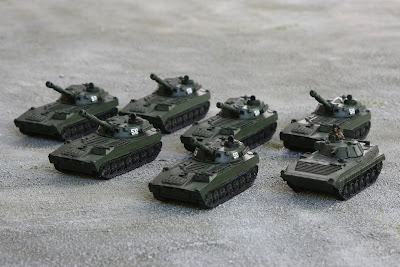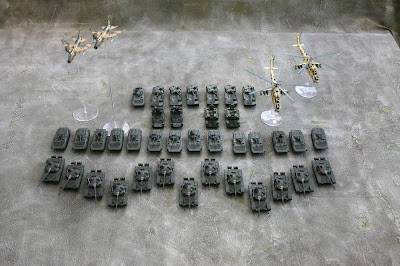As always, the year began with the Early War FOW competition at ValleyCon. I ran a British Motor Company themed on 1st Armoured Brigade in Greece. I won four games out of seven, placing mid table, and winning Best Army.
Item three on my list was Team Yankee, and this was one of my main painting efforts for the year, putting together 100+ points of Soviets. There are only two of us at the club that play in 15mm, but we had some enjoyable games in March and November.
In May there was also a big multiplayer TY game in 6mm.
The major change during the year was FOW V4. I finished painting my Comets, although have not yet added the Cromwell CS tanks, and played a couple of enjoyable 1750pt 8x6 games with them in April. The plan had been to rebase my desert Brits and finish off a few odds and ends, but this didn't happen, partly because after the initial glow of some excellent tank battles using the new system, I became concerned about how it handles infantry combat. More on this in a later post, probably.
The last item on my list for the year was related to Impetus. I didn't add any light cavalry to my Florentines, so that task will roll over yet again. I was encouraged to play in V3 in June, despite hardly knowing the rules and only having a renaissance army to take to a competition that was classically themed, and had a great time.
My goals for 2018 are:
- Finalise my FOW list for ValleyCon 18 - I will be running an Afrika Korps list, but the details are not yet confirmed. The fact that I'm still at this stage of the process when the competition is only four weeks away is a pretty clear reflection of my feelings towards the game, given that in previous years I'd sorted my lists out in August, and spent the last three months of the year painting for it. I have the feeling that my interest in FOW will either live or die by how V4 performs at ValleyCon.
- Actually buy and paint some Italian light cavalry and Landsknechts for Impetus after two years of just talking about it.
- More Team Yankee. I want to add a NATO force for both the 30pt and 100pt formats, and hopefully lure a few more locals into at least trying the game in 15mm.
- I will be taking a close look at 'Fate of a Nation' when it is rereleased. The original version missed the mark in terms of game balance, but hopefully the extension of the game to 1973 fixes this.
- Not entirely unrelated to Item 1, a couple of us are going to be trying out Battlegroup and Chain of Command. I have picked up the core rules for Battlegroup, plus the Normandy and Market Garden supplements, but haven't put it on the table yet.














